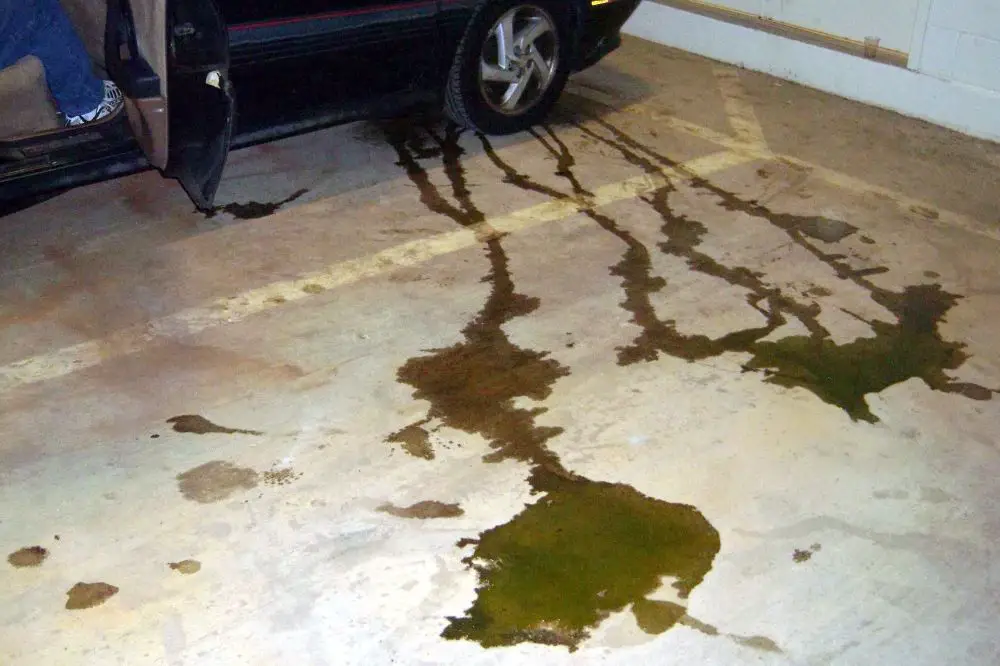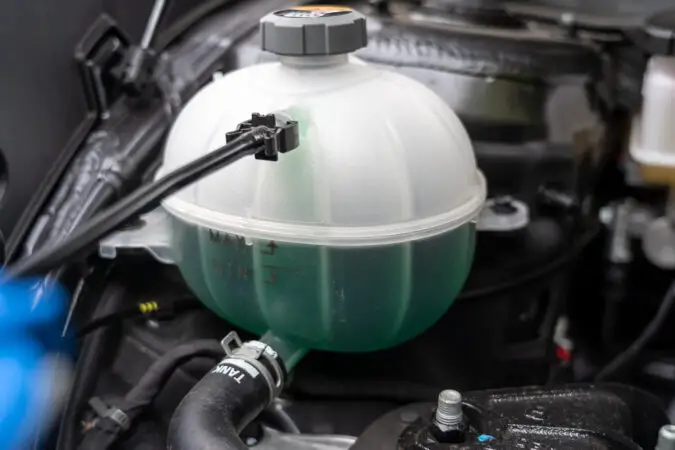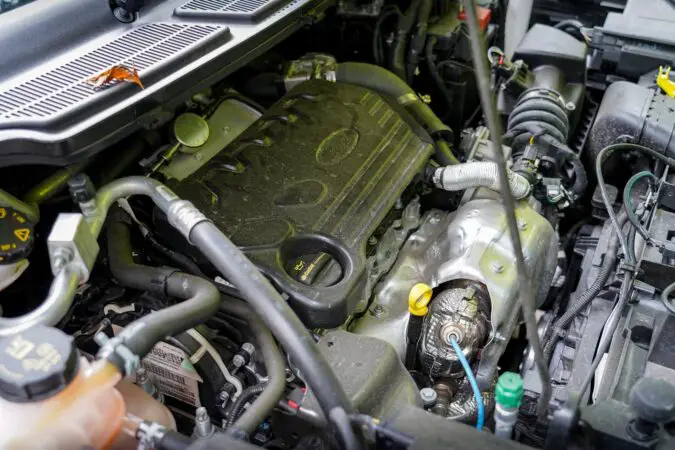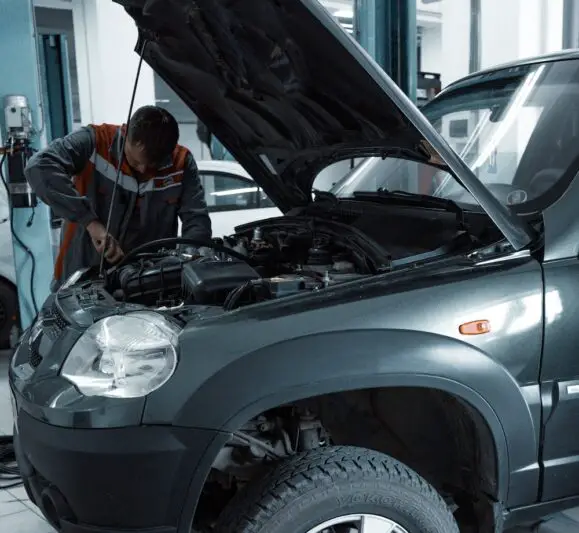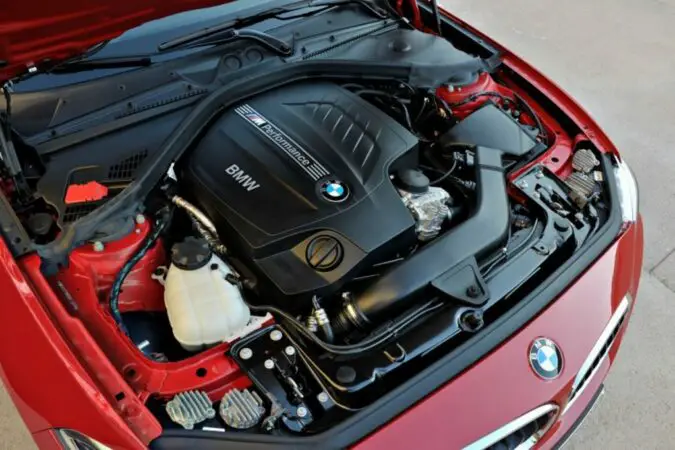Although the coolant leaking may not look like its serious, it could put the vehicle’s engine in danger. The car’s engine may overheat if you don’t have the right quantity of antifreeze. But what causes coolant leak?
Coolant should be checked frequently because it is so important to how well your engine performs. This is particularly true for older vehicles, which might not function as well as more recent models.
- Coolant Leak
- Coolant Leak Symptoms
- Coolant Repair Cost
- Water Pump Leak
- Coolant Pouring Out
- Frequently Asked Questions
Coolant Leak
The most obvious sign of a coolant leak is liquid on the garage floor (or wherever you park your car). It’s critical to know what to look for to identify the sort of fluid leaking from your engine because it’s not the only one that can happen.
Coolant typically has a sweet smell and is bright green, orange, or pink in color. Coolant leaks should always be cleaned up right away because it is extremely harmful to both people and animals.
What Causes Coolant Leak #1 – Hole In Radiator
All of the engine components in your automobile must withstand a great deal of wear and high temperatures, and this damages them in different ways. What causes coolant leaks is internal radiator corrosion. But this is just one factor.
You may find that there is debris or silt within the car’s tubes as the days go by and they will wear, which results in to break and subsequently a leak. Another part that could end up wearing out and result in a leak is the gasket that seals the tank to the radiator.
The hoses that connect to the radiator may also be to blame; as they age, your hoses will get hard and brittle and won’t seal as well. As a result, leaks can occur at the points where they connect to the heater core, water pump car, and radiator.
What Causes Coolant Leak #2 – Leaking Radiator Cap
Despite being small, the radiator cap serves a significant function. The cap is in charge of forming a tight seal that maintains the cooling system’s proper pressure despite the radiator’s high pressure. The spring may begin to wear down or the seal may weaken with time, allowing coolant to leak.
What Causes Coolant Leak #3 – Blown Head Gasket
The head gasket of your car will greatly impact how well your engine operates. You might not notice a blown head gasket for a while. Before you start to detect an issue, you might travel for a distance of several miles.
The head gasket must endure a wide variety of temperatures as well as extremely high and extremely low engine pressure. It is referred to as “blown” when it develops a leak and is located between the cylinder head and the engine block.
That makes it incapable of keeping the coolant and engine oil separate, which is exceedingly dangerous and can result in engine failure. Additionally, it may cause coolant to leak outside of the engine; as a result, your car’s cooling capacity may decline as the coolant level does.
What Causes Coolant Leak #4 – Faulty Water Pump
To make sure that coolant is circulated throughout the cooling system, the water pump is essential. It is situated in the lower portion of the engine, next to the drive belts, and is often driven by a belt.
It is connected to the radiator’s bottom hose, although occasionally that hose connection can come unfastened or corrode. Additionally, it could sustain external damage of some kind that results in a leak.
Your engine will eventually overheat if a water pump issue prevents it from circulating coolant throughout the system, regardless of the underlying cause.
What Causes Coolant Leak #5 – Faulty Expansion Tank
Cars have an expansion tank, which is the plastic container next to the engine, to aid provide coolant to the radiator. It typically has a rubber hose connecting it to the radiator, and as the engine heats up or cools down, it either feeds or takes the coolant to the radiator as well as from it.
That plastic may deteriorate with time and exposure to temperature changes, which could also affect the parts that are attached to it. Another answer to what causes coolant leaks is a faulty container cap.
The container or even the cap could shatter, thus letting the coolant leak out. Yet another possible scenario is that the connecting hose to the radiator will begin to wear, resulting in a fluid leak.
Coolant Leak Symptoms
Now that you know what causes coolant leak, the question is: how can you tell whether your automobile has a coolant leak issue? The solutions are rather straightforward; all you have to do is thoroughly inspect the vehicle and look out for the following items:
1. Coolant Puddle
If your car has a coolant leak and has been in the same spot for a long time, you might discover a sizable coolant puddle directly beneath your automobile. Here, the rate at which the coolant is leaking also has a significant impact.
However, if your automobile hasn’t moved from the spot for a while, you will undoubtedly find a sizable, obvious puddle underneath it. Most car manufacturers’ coolants are typically brightly colored—such as red, orange, green, pink, or blue—so they may be easily distinguished from other automotive fluids.
2. Overheated Engines
Still, wondering what causes coolant leak? Finding a puddle beneath your automobile is not always essential if the coolant leak is slight. Leakage at a low flow rate, however, is even more concerning because you won’t ever be aware of it. The shortage of coolant in your car’s engine is evident if you only use it for short distances and the engine still overheats.
3. Low Coolant Level
Every car has an expansion tank or reservoir that stores more coolant in case the engine coolant level lowers. The car refills the expansion tank from the reservoir itself. If the reservoir tank itself has no coolant in it, the automobile has likely consumed all of the coolant and has to be refilled.
If that occurs frequently and the expansion tank empties again after a short period, the coolant may be leaking someplace. As a result, you should visit a workshop right away and have a mechanic check the issue.
4. Coolant Warning Light
Every car has a coolant warning light in addition to the other warning lights. You will always notice a warning light glowing in your automobile whenever the coolant level in your vehicle drops, which is once more an obvious indication that the coolant level is low.
Although the coolant needs occasional changing, there is a good likelihood that the coolant is leaking if the warning light on your automobile is regular.
5. Radiator Floaters
There shouldn’t be any bubbles inside since the radiator pipes and coolant expansion tanks typically have a tight seal. The engine’s exhaust gases can, however, spill into the radiator or the expansion tank if there is a leak.
Consequently, you might see some bubbles there, which are essentially a sign of coolant leaking. Therefore, be sure to have your car’s radiator or coolant reservoir checked by experts if you observe bubbles.
6. Radiator Rust Or Discoloration
The condition of the radiator can also be used to determine whether coolant is leaking from your car. The radiator is utilized to generate heat while the engine is running; if coolant spills and drips on it, it will immediately boil and leave a stain or mark there.
Therefore, there is a good likelihood that your car’s coolant is leaking if you observe any kind of rusting or discoloration on the radiator body.
Coolant Leak Repair Cost
Coolants’ primary purposes are to transfer heat and safeguard the car engine from harm brought on by freezing or overheating. Engine components can overheat and wear out quickly without a working cooling system.
What causes coolant leak? One this is for sure, coolant leakage is not a good thing.
Long-term neglect of the leaks may result in expensive engine repairs. Depending on the type of vehicle you drive, your driving record, and the general state of the car, you should determine how frequently you should check the coolant.
Now that we will focus our attention on something different than what causes coolant leaks. For the time being, we’ll talk about the expense of fixing a coolant leak so you can estimate your repair costs.
How Much Does A Coolant Leak Repair Cost
Although it might not seem typical, the good news is that fixing a coolant leak won’t set you back a fortune. In most instances, this is a simple and affordable option. An estimated $100 will be required to fix a coolant leak.
In some circumstances, especially if it’s a small leak that only needs a seal, you’ll pay less than $100.
As no new parts are needed to correct the leak, in this case, you will only be responsible for labor costs. However, if the leak has been overlooked for a long time and has caused damage to further components that must be addressed separately for repair, the cost will be higher.
A coolant leak will typically cost roughly $900 to repair if you don’t fix the issue right away.
Important Indicators: Dealing with the issue quickly will help you save money on repairs. Minor coolant leaks may usually only require an hour to fix. It follows that you won’t have to wait long to get your automobile back. However, it can be challenging to find a coolant leak since liquid leaking onto a hot engine will quickly evaporate.
Water Pump Leaking Coolant
The water pump serves as the engine’s primary tool and is essential to the cooling system of a car. You must perform preventive maintenance and meticulous care to prevent the pump’s leaking and probable failure and to ensure a vehicle’s extended lifespan.
Primary reasons for water pump leaks include:
1. Using The Wrong Type Of Coolant
Only the proper coolant will accomplish its temperature-regulating task since the right coolant will come down to not only the type of car but also the climate and region in which the vehicle is to be driven.
The circuit can get blocked with solid residue if the wrong refrigerant is used, two different coolers are combined, or both, leading to leakage between the dynamic seal’s two contact sides. Corrosive deposits that can cause corrosion, cavitation damage, and blockage will eventually result from this.
Every engine is distinct and has various needs, thus it is crucial to follow manufacturer guidelines and carefully examine expiration dates when selecting the proper coolant.
2. Using Sealant Paste Improperly
Only those that come with no gasket require the use of sealant paste in water pumps. If so, keep in mind that using too much sealant during installation could harm the engine.
Applying the proper amount of paste is essential to prevent harming the pump’s internal seal since too much paste might clog the system and harm the mechanical seal, leading to leaks in the water pump and engine failure.
3. Dismantling And/Or Purging Of Ineffective Water Pumps
Never undervalue the role that a water pump’s impeller and housing design play in determining how efficient it is. A water pump’s interior components experience the majority of its wear. Take out all auxiliary and core devices, inspect them, and clean them separately to precisely check for wear at key components and guarantee optimal operation.
4. A Lack Of Maintenance Ahead Of Time
Professionals with the training, experience, and tools to examine, adjust, replace, and repair any components that aren’t working should constantly undertake maintenance.
Beyond this, experts must advise end users to investigate the health of their water pump a little more by doing routine inspections and taking into account best practices like replacing the water pump and distribution system at the same time for a durable vehicle repair.
In these methods, preventive maintenance as opposed to corrective maintenance enables the resolution of current defects before these have an impact on pump performance. Some of the most obvious indications of a failing water pump are…
Common Signs Of A Failing Water Pump
1. Leaking Coolant
A puddle of colored coolant on the ground just beneath your parked car is one of the first and most obvious signals of a potentially malfunctioning water pump. Coolant will leak from the pump if the sealing on the pump develops cracks or breaks.
In this situation, it is best to drive your car to the nearest mechanic right away for repairs because it may only require a quick fix.
2. An Overheated Engine
Your car’s engine will overheat if a dead water pump is unable to circulate coolant through it. If the temperature gauge indicates a temperature rise, you need to check it right away.
The likelihood of serious damage, such as damage to the cylinders, pistons, head gasket, or even an engine breakdown, increases as the engine temperature rises. If you continue to drive your car, the damage may become too severe to fix.
3. The Presence Of Corrosion And Rust
The water pump loses its ability to pump coolant due to rust and corrosion on its surface. You can see rust or tiny holes on the exterior of the pump when inspecting your car. If so, the water pump needs replacing because the one that has rust or is faulty cannot function properly.
https://www.youtube.com/watch?v=uRmk2qaUDPY
The use of an inappropriate coolant will eventually damage the dynamic seal, causing the pump to leak. Reddish and yellowish coloring, incrustations, white spots, as well as corrosion are signs that this is the case.
4. A Whining Sound
When your car is speeding, a high-pitched whining sound coming from the front of the engine may be a sign that the water pump is failing.
A whining sound that some people could characterize as harmonic buzzing will come from the front of the car if the water pump components are faulty or still too loose.
The belt may frequently be to blame for this noise. You’ll be safe from more severe damage by replacing it as part of your vehicle’s maintenance program.
How To Fix A Leaky Water Pump
Water pumps of high grade don’t leak when done properly. For example, some water pumps have their water tightness verified using a calibrated and incredibly accurate automatic leak-detecting machine. To prevent transient leakage, it is crucial to provide the following coolant conditions…
Make sure there are no solid particles smaller than 0.05mm dissolved in the coolant.
Constantly verify that the expansion vessel is within the minimum and maximum limits to ensure that there is no air in the cooling circuit. Air pressure fluctuations that are only momentary may result in a hydrostatic imbalance in the dynamic seal, which could lead to a brief leak.
Losing Coolant No Leak No Overheating
Your automobile requires antifreeze regardless of whatever vehicle you drive. Consequently, you must identify the reason for your coolant loss as soon as possible.
The three most frequent causes of an empty coolant reservoir are…
1. What Causes Coolant Leak, Empty Reservoir #1 – Head Gasket
A mechanic will likely explain the issue to you right away. The combustion chamber instead of the ground is where everything leaks when a head gasket fails, which is a common occurrence.
Even while there won’t be any obvious evidence on the ground, it will be rather obvious if you take a quick check at the exhaust.
There will be a great deal of white smoke coming from the exhaust if your head gasket has blown. This is because, regardless of the coolant color your automobile uses, coolant burns white as opposed to gas, which mostly emits clear or black exhaust emissions.
Expect your thermometer to climb far above average as well.
2. What Causes Coolant Leak, Empty Reservoir #2 – Radiator Cap
The engine will likely be burning the coolant somewhere else if there isn’t an internal leak. One of the more typical locations is the radiator. Radiator caps keep the pressure inside the system, but if they are not sealing properly, some steam-filled, highly pressurized coolant will leak out.
Once your engine has warmed up, a glance at your radiator cap will allow you to determine whether steam is escaping. If you notice any steam or smoke emerging from the cap, you should replace it immediately.
3. What Causes Coolant Leak, Empty Reservoir #3 – Leak Into The Engine Block
While a leak onto the engine block will usually eventually cause a puddle to form under your car, if the leak is occurring straight onto the top of the engine and is puddling up until the engine warms up, the coolant may be burned up before it can reach the ground.
The telltale symptom is a cloud of white smoke emerging from the engine bay while the engine is running, and although it’s uncommon, it can happen.
Coolant Pouring Out Of Bottom Of Car
At first, you wouldn’t notice anything different when your coolant level started to decline. The engine would gradually start to overheat the instant the coolant levels became too low. The parts of the car start to become more prone to damage next. This is why you can’t overlook the task of correcting coolant leaks.
1. Hoses
The coolant system of an automobile consists of at least four hoses, often known as fluid pipes. The placement of the hoses ensures that they transport coolant to and from the radiator. These hoses may experience cracking over time or as a result of extreme heat. The fissures may also cause leak points to emerge.
When coolant drips from the bottom of the automobile, this may be due to faulty hoses. For the replacement of hoses and fixtures so that there are proper coolant levels, go to a mechanic.
2. Radiator Cap
When you discover coolant seeping from the bottom of the automobile, another item to check for is a damaged radiator cap. The coolant would leak out of the end of the radiator whenever it heated up.
The radiator operates on the principle of pressure, and a cap helps to maintain this pressure. The pressure won’t build up if the cap isn’t tight, which leads to coolant loss.
When determining the cause of the leak, it is important to keep the pressure under control. You could accomplish this by reading the automobile’s owner’s manual or by consulting a car expert. For signs of a damaged radiator cap, you could also consult maintenance advice.
3. Blown Head Gasket
A component of the internal combustion engine is the head gasket. The head gasket’s ability to prevent coolant leaks is just one of its features. Due to their extensive surface area and susceptibility to temperature changes, head gaskets are susceptible to developing leaks.
A blown gasket head could be the cause of coolant leaks either from the exhaust or the intake manifold.
Fix the head gasket leaks right away because they will get worse over time. To investigate the problem, you should look at your car’s engine temperature gauge.
If you notice that the temperature is rising unusually, the coolant leak could be caused by a burst head gasket.
Frequently Asked Questions
Is Antifreeze Coolant
Antifreeze, commonly referred to as engine coolant, is combined with water to prevent the radiator from freezing in extremely cold weather and overheating in extremely hot weather. Knowing which type of coolant is best for the car or truck is crucial because there are numerous variations.
Does Antifreeze Expire
Antifreeze has an endless shelf life when it is in a sealed bottle. If kept in the original container after being opened, it will last for many years. Even while both antifreeze and pre-mixed engine coolant have a long lifespan, antifreeze tends to survive even longer.
Does Coolant Evaporate
It is not exposed to the atmosphere, thus it does not evaporate. It is pressure-sealed at operating temperatures in a closed-loop system. If the radiator cap or coolant tank cap were left off, you would ultimately lose some coolant to evaporation, but under normal circumstances, the volume is constant.

